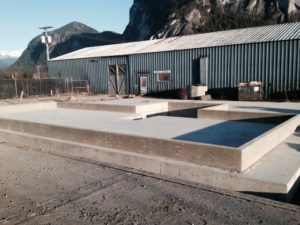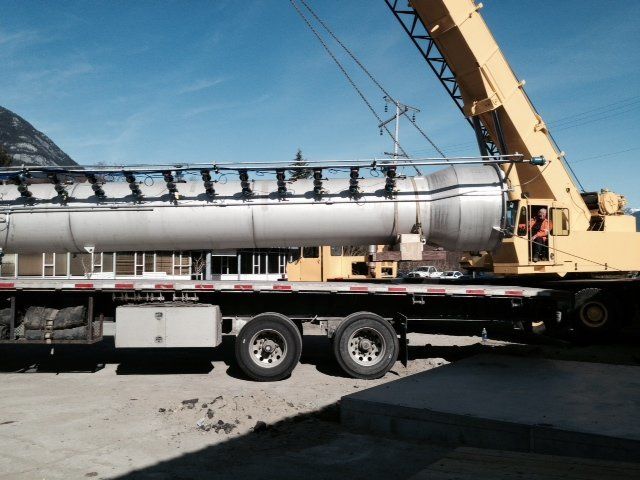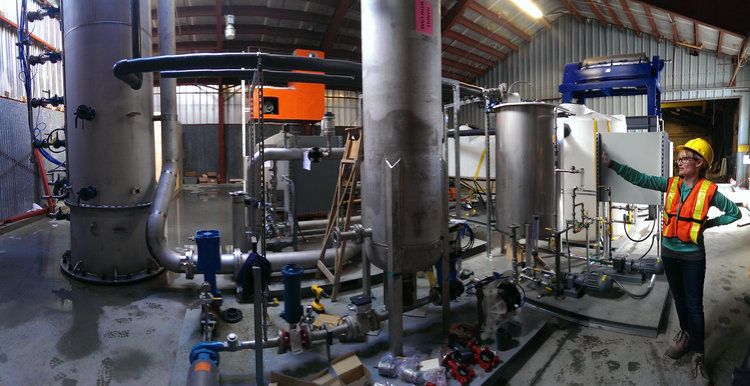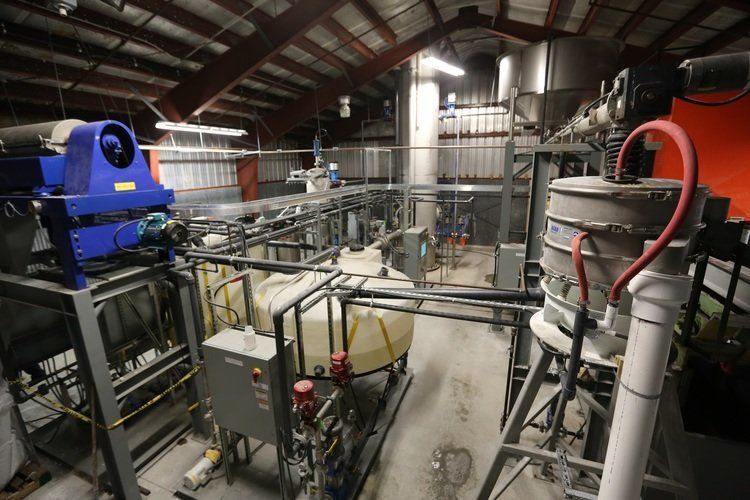Source: huffingtonpost.com
Published: July 5, 2016

Carbon Engineering’s carbon capture plant in Squamish. Carbon Engineering
It’s capturing carbon dioxide directly from the atmosphere for fuel that planes and trucks could one day use.
By Dominique Mosbergen
In an industrial plant in Squamish, British Columbia, a picturesque town near Vancouver where snow-capped mountains touch the sea, an environmental revolution is afoot.
Scientists are sucking up carbon dioxide directly from the atmosphere — and turning it into fuel.
A growing crop of companies, including Carbon Engineering, the Bill Gates-funded Canadian firm behind the Squamish plant, are banking on this direct air capture technology being a potential solution to the planet’s climate woes.
A Carbon Cache
Scientists have warned that unless global temperature rise is limited to below 2 degrees Celcius above pre-industrial levels, the damage to our planet may be dire and, in some cases, irreversible. But to achieve this goal, net carbon dioxide emissions must decrease to nearly zero by 2050, experts say.
That’s a target that many believe we’re not going to hit.
“The climate policy mantra — that time is running out for 2C but we can still make it if we act now — is scientific nonsense,” wrote Oliver Geden, head of research at the German Institute for International and Security Affairs in the journal Nature last May.
Scientific teams have scrambled to find strategies to tackle the climate crisis in the wake of such ominous predictions. Most of these plans have thus far focused on reducing emissions, such as adopting cleaner energy sources and agricultural processes. But in recent years, the conversation has expanded to include another possible solution: capturing emissions.
Specifically, capturing carbon dioxide directly from the air and also from fossil fuel-burning power plants and other CO2 sources, and burying this gas deep underground (a process referred to as carbon capture and storage or CCS).
Some scientists, including those on the Intergovernmental Panel on Climate Change, believe the world has “little chance” of achieving the 2-degree goal without carbon storage.
“Fossil fuels aren’t disappearing anytime soon,” John Thompson, director of the Fossil Fuel Transition Project for the non-profit Clean Air Task Force, told Environment 360 in 2014. “If we’re serious about preventing global warming, we’re going to have to find a way to use those fuels without the carbon going into the atmosphere. It seems inconceivable that we can do that without a significant amount of carbon capture and storage.”

Carbon Engineering The Carbon Engineering plant in Squamish.
Scientists have embarked on small-scale CCS projects in the past and its potential importance in the fight against global warming has been widely discussed, but experts stress it may take decades before the technology can be deployed in a widespread, cost-effective and scalable way.
This massive carbon cache will need a great deal of funding. Such a benefactor does not currently exist.
“The world is not ready yet [for CSS],” Adrian Corless, CEO of Carbon Engineering, told The Huffington Post from his home in Squamish last week. “There will need to be some global coordination of effort, but for now, there’s no global strategy in place.”
In the interim, companies like Corless‘ are attempting to turn carbon capturing into a viable business.
There are about a half dozen companies worldwide tackling direct air capture technology, which Corless compared to very efficient trees sucking up carbon dioxide already emitted into the atmosphere. At least three of these firms are relying on so-called “air-to-fuels” to be their golden goose.
New York City-based Global Thermostat, led by Peter Eisenberger, a Columbia University professor and former researcher for Exxon and Bell Labs, has vowed to “turn carbon pollution into cash.” And Swiss company Climeworks, in partnership with Audi and Sunfire, a German oil company, wowed many last year with its “miracle,” low-carbon diesel fuel made out of “water and air.”
Now Carbon Engineering, originally the idea of Harvard physicist David Keith, says its one step closer to commercializing this technology. Its Squamish plant is in the process of perfecting its fuel synthesization process. This involves the splitting of water into oxygen and hydrogen before combining the hydrogen with captured carbon dioxide to create hydrocarbon fuel. The company uses clean energy, like solar and wind, to power the whole process.

Carbon Engineering This simple graphic shows how Carbon Engineering captures carbon dioxide from the air. The next step in the process is the synthesization of fuel using the captured CO2.
The firm aims to start selling its low-carbon fuel in 2019.
“To start, we’ll have one commercial plant producing about 1,000 barrels of synthetic fuel a day,” Corless said.
To achieve this, 100,000 tons of CO2 will be harvested from the atmosphere per year — equivalent to the carbon footprint of about 25,000 vehicles.
That might not sound like much to combat the global climate crisis, but Corless said what’s perhaps most exciting about Carbon Engineering’s technology is its inherent scalability. “Our process likes to be done at a very large scale, so we could eventually tackle a much bigger problem,” he said.
Eventually, a Carbon Engineering plant could create up to 10,000 barrels of fuel a day — and “that would just be one plant,” Corless said. The company aims to eventually build enough plants to capture many millions of tons of CO2 from the air.
And it could do so relatively affordably, it claims. While some experts have estimated that direct air capture would cost $400 to $1,000 per ton of carbon dioxide, Carbon Engineering says its plants could do it for about $100 per ton.

Carbon Engineering. At the Carbon Engineering plant, huge amounts of air is pushed by large fans through a liquid solution which absorbs the CO2. This is then processed, using lime, into purified carbon dioxide. The clean air is released back into the atmosphere, and the liquid solution is recycled to be used again.
Still, the fuel — which Corless said would be best used by airplanes and heavy vehicles like trucks — would not be cheap.
Corless estimates the fuel will cost about $4 to $6 a gallon, but he’s confident he’ll find buyers in places like California, British Columbia and the European Union, where regulations are pushing companies and governments to decarbonize transportation.
The synthesized fuel will contain less than one-third the carbon content of conventional gasoline and there would be “no extra costs to the customer in terms of switching to a new fuel,” Corless said.
Ultimately, he believes air-to-fuels could one day play a significant role in the decarbonization of the transportation sector as a whole. In the U.S., transportation is the second largest contributor of greenhouse gas emissions, accounting for more than a quarter of all emissions in the country.
“Certainly, [this technology] won’t be the one and only thing to solve the problem of carbon in the atmosphere, but the fact that this tech is so scalable, it’s going to allow us to tackle net zero carbon sooner,” he said.

Carbon Engineering. The air we breathe contains just 0.04 percent carbon dioxide, yet direct air capture technology is able to remove the greenhouse gas.

Carbon Engineering. Direct air capture is able to suck up carbon dioxide that’s already been emitted by cars, planes, agricultural equipment and other sources.
A ‘Willing Audience’
Many people were dubious of direct air capture when climate scientist David Keith established Carbon Engineering in 2009, Corless said.
The technology had been around for a few years, experimented with in university laboratories; but from a commercial standpoint, the future remained hazy.
“People were asking, ‘Did it make sense? Was it time to take it out of the university?’ It was at this point that David had a conversation with Bill Gates, [Canadian oil baron] Murray Edward and other investors, and they said they’d step up,” Corless said. “In the years since, we’ve the privilege and luxury of having the support of high-net worth individuals who really care about climate. It’s thanks to their vision that we got this seven-year head start.”
Gates and Edward, the billionaire chairman of Canadian Natural Resources, one of Canada’s largest oil-sands mine operators, have continued to invest in the company. Carbon Engineering closed a new $6.2 million round of financing in May from investors including the Microsoft founder and the oil magnate.
Keith said the recent investment is proof that the world may be finally ripe to embrace this technology. He also addressed skeptics who have pointed out carbon capture’s limitations, such as its its high cost and the risk that the technology will breed complacency and “false hope.”
“Most people in the energy expert space think that air capture is not particularly credible,” he told MIT Technology Review earlier this year. “There won’t be incentives and funding in a serious way for these technologies unless people believe that they actually work.”
Public dialogue around carbon and climate has been “accelerating in recent years,” Corless said.
“We’re fortunate right now to be operating at a point in time that globally people are shifting their focus to carbon and I think this is the right time for our company to be deploying this technology,” he added.
“We have a much more willing audience than we would have a few years ago. I’m very excited.”
